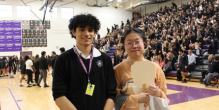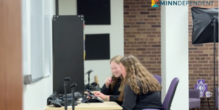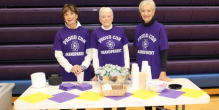Learning Goes the Distance
Reprinted from Traditions, Summer 2020
August 26, 2020
Note: This story is about Online School in the spring of 2020. CDH is beginning the 2020-21 school year with a hybrid model. Learn more here.
We all know how it happened. There was the news out of China, then the first reported case in the United States. Then, Italy locked down. There was the NBA player joking about the virus, who reported that he was infected just a couple of days later. Cruise ships stuck at sea, professional sports canceled, and within just a couple of weeks, COVID-19 was no longer a distant news story, but the largest disruptor of normalcy seen in many of our lifetimes.
The pandemic sparked broad and unprecedented measures to minimize the spread of this new virus and increase the chance that the medical system had the capacity to care for those infected. It soon became clear that even schools would not be able to operate as normal.
As schools shut down across the nation, CDH teachers and administrators rolled up their sleeves to develop a plan for a whole new way to deliver education.
“To keep the students connected with teachers was our number one goal,” said Principal Mona Passman. “We wanted it to be meaningful and relevant and keep the kids engaged. We had to figure out how to do that, how to keep expectations at the right level in this totally new environment. Plus, the sense of community is such a huge part of the CDH experience — how do we maintain that from a distance?”
On Friday, March 13, Assistant Principal Amy Bellus ’90 instructed students to bring home all of their class materials — just in case they didn’t come back on campus right away after a scheduled long weekend.
“Right at that moment, it hit me that we might not be back all year,” said Kerry Salisbury ’21. “I was definitely scared: I’ve never done online school, I’ve always had the same routine.”
CDH was already scheduled for a long weekend for a teacher in-service, added just one additional day of prep, and quickly launched online school on March 19, making us one of the first schools in Minnesota to make the leap.
Online School the CDH Way
The logistics of online school were completely different from the regular school day. The schedule was divided into “A” and “B” days to accommodate distance learning. Each class period was given an assigned time for Google Meets (virtual video meetings). The school day lasted from 9:30 am–2 pm, out of a recognition that many students would be taking on more responsibilities at home, such as caring for younger siblings. Students were required to check their email before 9:30 am each morning, be available for scheduled Google Meets, and submit any assignments by midnight the day they were due. There were no passing periods, no chatting by the lockers, no club meetings during lunch, and no school uniforms.
However, one thing stayed the same: our teachers’ commitment to their education.
“Distance learning caused all of us to reevaluate what is most essential,” said Passman. “Our teachers had to decide what was critical learning and latch on to that; they had to reexamine why they did things the way they do. After teaching the same classes for years, some things become automatic. It wasn’t automatic anymore. Every teacher I’ve talked to says they’re a better teacher after all this.”
The creative educators quickly sought out new ways to not only teach their material but keep students engaged.
For example, Social Studies teacher Morgan Lieske began giving group quizzes in which she invited a small group of students to a Google Meet and quizzed them as a group — grading on both their answers and their collaboration.
“It’s been a great way to have them talk through concepts and enables me to hear that they are actually talking through the material, not just trying to look up the answers. I will likely continue to do something like this when we return to campus because it showcases the social and interpersonal learner,” Lieske said.
In the Science department, Stephanie Aumann sent all of her Physics by Inquiry students home with a set of lab equipment, sending them instructions for experiments and splitting them into small groups to discuss what they learned.
Theater Director Katie Kreitzer’s Improv class met online each day, creating skits that were a perfect fit for the moment — with improv themes such as a therapist visit via Zoom, friends hanging out on Zoom, fighting with faraway family on Zoom. She also took advantage of our new virtual world to bring distant alums into the classroom. Three technical theater professionals made time to talk with her Technical Theater class.
“When I surveyed the kids at the end of the year, they all said that was their favorite day,” Kreitzer said. “I’ve always had these alums and their stories at my fingertips, but I’ve never used them. That’s definitely going in the curriculum next year.”
Of course, it wasn’t all easy. Every teacher mourned the loss of the in-person connection. Teachers were challenged to find new ways of getting feedback.
“I can usually read the room,” Aumann said. “Am I going too fast? Do they get it? Can I check-in quietly on someone who looks confused? Here, I had to rely on asking them all for a thumbs up/thumbs down, and hope that students would reach out if they needed help.”
Some students thrived in the new environment. The lack of classroom distractions made it easier for them to focus on their schoolwork, and their grades went up. Teachers and administrators are already looking at ways to bring that experience into the school setting.
“We’ll continue to take a look at the curriculum and see where we can deliver a quality education efficiently, with options outside of the ordinary school day — perhaps a select number of classes online, like in college,” said President Frank Miley. “I’m not talking about a lot of them, but for those kids who found success in such a format, it may be a good option. We are dedicated to different learning styles and if this learning structure is really good for some students, this may be an opportunity.”
Other students needed a lot of support through the transition.
“Some kids had a really hard time with the organizational part of doing online school and that’s where I spent most of my time,” Bellus said. “I was talking to kids about how to organize, check email, make lists, check things off when you get done, and pay attention to what’s due when.”
Bellus notes that much of her job is typically about discipline, so this was new.
“I really enjoyed being more proactive about helping our students operate in this new structure and finding ways I can help them. When we return, I look forward to working with kids who may be dealing with academic and social struggles earlier — before they show up in my office for behavior issues.”
Even for students who were able to make the transition easily, the loss of in-person classroom time was difficult.
“Weirdly, I really missed taking tests in class,” Salisbury said, “Just the environment of everyone around me focusing on the same thing and knowing the teacher was right there — it’s not the same doing it at home.” Of course, academics weren’t the only thing that changed when the school building shut down.
The boys basketball team won their section on March 12 with a buzzer-beater by Curtis Jones ’20. The state tournament was canceled the next day.
“You can imagine the emotion in the locker room when I told them State had been canceled,” said Coach Jerry Kline ’93. “We went from jumping for joy to suddenly knowing it wouldn’t happen.”
The spring musical, “Holiday Inn,” was halfway through rehearsals when they were sent home, and the cast spent the next six weeks unsure if they would have the opportunity to perform. They eventually created a virtual production, available on YouTube.
Spring sports were first delayed and then called off, blood drives were canceled, and longstanding JROTC traditions never happened.
Class of 2020 Feels the Loss
The Class of 2020 experienced a particular kind of loss. They didn’t have the opportunity to experience beloved CDH traditions they’ve been looking forward to throughout high school. Sent home in the middle of March, they missed out on Prom, Lock-In, and the last day of school. Instead of a communal Last Supper, teachers and parents delivered hot meals from Tinucci’s to seniors’ homes and the class participated in a virtual talent show. Graduation took place at the Cathedral on August 2 — nearly five months since the last time students were together on campus.
With a heartfelt desire to show the seniors how much they were missed and to celebrate their final months, a surprise was orchestrated by the teachers and parents early in the quarantine. Seniors were honored by the delivery of yard signs honoring the CDH Class of 2020.
“I can’t tell you how much it meant to look out on our front lawn and see this sign,” said Mary Hernandez, mother of Sam Hernandez ’20. “That CDH remembered our son in this crazy time, and reminded us of what a momentous year it is for him, is just so outstanding.”
Economic Downturn and the Impact on CDH
Of course, CDH was not only impacted by the need for social distancing — our community has also been hit hard by the resulting shutdown of the economy.
Some of our families have experienced a loss of income because of the impact COVID-19 has on the economy, making it difficult to afford a CDH education. CDH does not want to lose any students because of this crisis and quickly established a COVID-19 Emergency Tuition Relief Fund. We asked our community to support families in need, and our donors stepped up, with many of them making their second gifts of the year.
“For families who have worked hard to invest in and support their children’s education, and who suddenly find themselves without the means to continue that support, the difficult choice to discontinue that opportunity just feels so wrong,” said donor Martha Hanzel Johnson ’87. “Coming together to support each other is what the CDH community does best and what makes the school unique, and we wanted to be a part of that.”
The employees were also affected. When the school building closed, our teachers and most staff continued working from home. However, some staff members simply couldn’t perform their job duties if they were not on campus.
“For those people whose work was solely tied to being in the building, we committed to carrying them financially through the fiscal year, which was June 30,” Miley said. “We made a commitment early on not to furlough or let anybody go. We recognized that we have an obligation to the individual to make sure their basic needs are met — there’s tremendous dignity in that. It was the right thing to do.”
All in This Together
Throughout this experience, the Cretin-Derham Hall community responded with inspiring dedication and creativity. Virtual meetings replaced classroom chatter. Dining room tables became desks. Coaches stayed in touch with their teams, encouraging them to stay in shape and connect with their teammates. Art classes created expressive work about the experience of living through a pandemic. Parents of younger students jumped in to help honor seniors with special deliveries. Teachers with more knowledge of technical tools and apps for educators coached those with less. Students, teachers, and administrators shared a daily prayer on Instagram. Special events such as the Grandparents Mass and Awards Assembly were held on YouTube, with a live comment stream from the community, rather than in the Field House. Even the CASA families worked together by completing individual or group tasks to compete for the 2020 Quarantine Cup.
“I’m so proud of the collaboration we saw throughout this experience,” said Passman. “We were up and running with real learning very quickly because our teachers were dedicated to making this experience positive and valuable for our students. We learned a lot along the way, and we figured out how to do this with a high level of quality.”
“We also believe that online school wasn’t the same and we truly missed our students and the energy on campus,” explained Passman. “While I wouldn’t ever want to do it again, we are so very proud of our students and our community who responded with admirable resilience and hard work. Together, we created the best experience we could.”
Subscribe to our e-Newsletters
You might also like:
Asian American Pacific Islander Month Is Celebrated with Cultural Showcase
Student speakers Xinyue (Luna) Cui '25 and Keyon Archer '25, along with performances by two cultural groups were in the spotlight at the AAPI celebration.
CDH Center for Digital Storytelling Opens
Our CDH Center for Digital Storytelling is equipped with state-of-the-art resources to support our teachers’ instructional practices and help engage students in additional learning experiences.
The Grandparents Association Makes a Difference in Students' Lives
The Grandparents' Association at CDH offers numerous opportunities for grandparents to get involved and make a meaningful impact.




